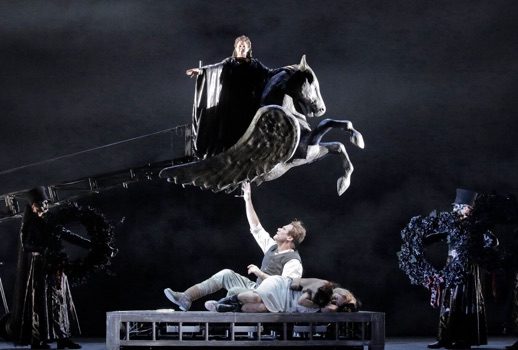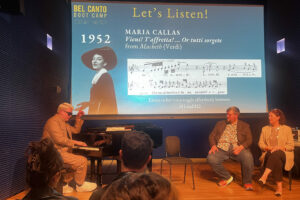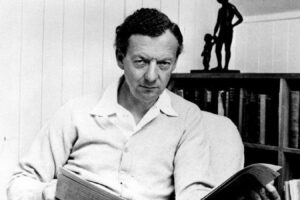

Joy cometh in the mourning
Once you’ve assembled the musical materials for a first-rate Die Walküre—and the new production at the Lyric Opera of Chicago has a fine conductor and six excellent singers in its six big roles, and when did you last encounter that combination?—you still need to make sense of the intricate stage drama with a vision that can expand to encompass the entire Ring.
LOC began David Pountney’s Ring last year with a well-received Rheingold. My guess is the Norns figured in it (though they do not sing), because they did a brief mimed interaction during the stormy prelude of Die Walküre with Wotan (Eric Owens in a long white smock with red lines on it depicting either a bloody ash tree or Teutonic knotwork—perhaps a mix of both).
This points out one of Pountney’s irritating traits: if there is an orchestral interlude between scenes, he cannot leave it alone to express whatever the music expresses; he feels he must fill it with activity, even if the activity has nothing to do with the leitmotiven being played. The Norns and Wotan are not in the score of the Vorspiel to Die Walküre, but here, for an instant, they are.
After that, it’s a fairly traditional post-Patrice-Chereau Ring, set during the Industrial Revolution. Siegmund, Our Mutual Enemy, wears a Dickensian waistcoat and baggy trousers. Sieglinde is unable to offer him a cup of water because she is physically chained to the ash tree that snakes like an S through Hunding’s residence, a dark, satanic Wordsworthian mill, bare brick walls and heavy metal doors. The walls fly up to reveal a realistic Spring-filled wood.
Wotan’s sanctum (the upper two-thirds of the huge Lyric stage) is a columniated hall with vitrines full of raven’s heads and decanters full of restorative ambrosia. The gods wear haute-bourgeois togs when Wotan is not out working. (The sets are by Robert Innes Hopkins; the severe, interesting costumes by Marie-Jeanne Lecca.) There’s a telescope to keep an eye on earthly goings-on.
One Pountney intrusion (during the prelude to Act II) is to make Brünnhilde human, all too human. One expects the steely-hearted goddess, up until the moment she feels Siegmund’s pain and becomes, ipso facto, a woman. But this Brünnhilde (Christine Goerke, vocally very much at ease in the role after three or four Rings) gets all romantic and gushy about the lovers’ forest glade. This seems out of line, the line of her persona. Later, she pours her depressed daddy a stiff one from those decanters.
Act III will startle: The valkyries are red-smocked EMS workers in some plague hospital, cleaning up the bodies for their debut in Valhalla, killing the ones that aren’t quite dead. One of them even has a clipboard, checking off names. Why? Because it’s never been done that way?
When Wotan reduces the girls to pleading children, they sit on children’s chairs as if on Romper Room. When he threatens Brünnhilde with a human husband, a bunch of creepy guys in trench coats and slouch hats leches around an unhappy Goerke. For Pountney, Brünnhilde is not the noble goddess who insists on the most fearless of men, but the girl next door, someone who’s been reading about gropy celebrities. It’s very up to the 2017 minute, and therefore it is not Wagner’s archetypal myth. Wagner’s Brünnhilde is very much not the girl next door.
When Wotan summoned Loge, a cubicle arose from the stage in which a muscly go-go-god did dancing somersaults, backed by a hologram of fire. That’s pretty magical, actually, with a sleeping Brünnhilde atop the cube, rising ever higher at center stage.
In the “Todesverkundigung,” Brünnhilde appears on a “flying horse” manipulated by visible stagehands (another Chereau-ism). This comes off because Siegmund (Brandon Jovanovich), stage center, is visibly asleep, dreaming the whole encounter, which includes a shuffling chorus of top-hatted Victorian mourners with huge black wreaths.
There is actually no reason for Brünnhilde to bother to warn Siegmund, except that Wagner wanted the Aeschylean dialogue between the two to lead to the crux of his drama, the valkyrie’s transformation to a human being. If the vision is Siegmund’s subconscious speaking, it answers certain questions … but raises others. When does the dream cease? When does he wake up? When are we back in the actual world? Pountney opens a parenthesis but fails to resolve it.
Still, it is a handsome, fairly clear narration, that would work well even if LOC had given it less than first-rate Wagnerians to sing it. But all six of the leading singers are terrific, and the mellifluous valkyries slouch not neither do they scream. It was the finest all-around Walküre cast I’ve heard in a month of Woden’s Days.
For one thing, it was my first opportunity to hear Goerke, sing Wagner. Over the years I have admired her in operas by Handel, Mozart, Gluck, Puccini, Strauss and Berlioz, the voice fleshing out though she, paradoxically, has gotten slimmer—or maybe it’s just that her Handel heroines, Armida and Alcina, were costumed in bustiers.
Handel appears to have taught her lessons on keeping the voice flexible for abrupt emotional mood-swings, audible in her solid Wagner vocalism. Solid—but not hard—a warm, opera house-filling sound, a demigoddess even when Pountney’s direction undercuts her. She had health problems early in this run, and she ducked the final iteration of her war cry on November 18, but she has settled into this signature role.
Eric Owens may lack the whelming sound of some well-furbished Wotans, but he compensates with touches of subtle, internal vocal acting, expressing the god’s anguish at necessary actions and frustrations. Accordingly, he remained in sturdy voice through the end.
As his consort, Tanja Ariane Baumgartner, a tall slim woman costumed in a handsome raspberry suit, cut a commanding, even tragic figure, singing Fricka with a warm, enormous mezzo, a wife worried about her husband’s self-deceptions rather than an offended shrew.
Brandon Jovanovich, whose Aeneas thrilled Chicago last year in the company’s first Les Troyens, sang a more tormented than romantic Siegmund. As a performer, nothing daunts him: He can pick up his soprano in his arms or leap atop a table between singing two attractive phrases. He is a heroic figure, tall as any Hunding, a fine musician and a vivid presence.
Elisabet Strid, the lady he lifts, is a short woman with an impressive figure. She sings many Wagner heroines in Europe but is making her debut here. She has the full-bodied sound of a true Wagnerian, and acted the role as if living Sieglinde’s torments and forebodings—her two narratives in Act II rang especially true. I could have done with less ardent stroking of Siegmund’s sword, but stage directors seldom seem to understand when less is more.
Ain Anger—who looks and sounds like he sings the Giants, and often does—made a sardonic Hunding. This production gives him a scene (to leitmotivically inappropriate music) to bring on his pack of hounds, whom he incites with a sniff of Sieglinde’s clothing. The hounds are played by half-naked dancers with wolf’s heads because it’s opera, any excuse for a bare male torso, right?
The LOC’s music director, Sir Andrew Davis, is celebrating his thirtieth season with the company, a period that has included a couple of Ring cycles. He led a swift-paced performance, held tightly together, never sleepy and often rivetingly dramatic. There were times one might have preferred to relax and dwell on the more elegiac themes, but this was not Davis’s vision, and his attitude synchronized with Pountney’s somewhat overthought direction. Trajectory was determined and effective. This was a Walküre to inspire any Wagnerian to return—for the astonishing level of the singing, but not only for the singing.
Photo: Cory Weaver


























Comments